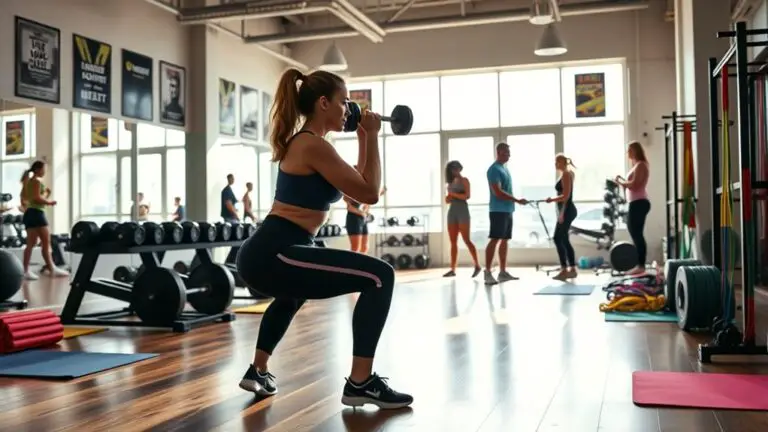How to Train for Your First Muscle-Up at the Gym

To train for your first muscle-up, you’ll need to build strength, technique, and explosiveness. Start by evaluating your current strength—aim for 5-10 clean pull-ups and dips. Incorporate essential exercises like hollow body holds and ab wheel rollouts to boost your core. Master pull-up and dip techniques, and add explosive movements like box jumps and clap push-ups for power. Create a structured training plan, and set achievable goals. Keep pushing yourself, and you’ll uncover more effective strategies along the way!
Understanding the Muscle-Up Movement

To grasp the muscle-up movement, it’s essential to break it down into its core components. First, focus on the muscle-up mechanics, which involve a powerful pull-up followed by a seamless shift into a dip. You need to engage your core and drive your knees upward as you pull yourself up. This upward momentum is vital for achieving movement efficiency.
Next, work on your grip and hand positioning; a false grip can make all the difference. As you pull, think about leaning your chest forward to prepare for the shift to the dip. This will help you maintain control and balance during the movement.
Lastly, practice consistently. Each attempt is a step closer to mastering the muscle-up. Remember, every small improvement in your technique contributes to greater efficiency and success. Stay focused, keep pushing your limits, and soon you’ll find yourself soaring above the bar with confidence.
Assessing Your Current Strength Level
To successfully train for a muscle-up, you first need to evaluate your upper body strength and core stability. Analyzing these areas will give you a clearer picture of where you’re at and what you need to work on. This self-assessment is essential for creating a focused training plan that sets you up for success.
Evaluate Upper Body Strength
Evaluating your upper body strength is essential before attempting a muscle-up, and it starts with understanding your current fitness level. Begin your strength evaluation by testing your ability to perform basic exercises like pull-ups and dips. Aim for at least 5-10 clean pull-ups and 5-10 dips to gauge your readiness. If you struggle with these, focus on building foundational strength first. Incorporate exercises like push-ups, rows, and band-assisted pull-ups to strengthen your upper body. Track your progress consistently; this will help you set realistic goals. Remember, muscle-ups require not just strength but also technique. By honestly evaluating your current upper body strength, you can create a targeted plan that will lead you closer to achieving your muscle-up goals.
Analyze Core Stability
While upper body strength is essential for a muscle-up, core stability plays an equally important role in your overall performance. To guarantee you’re ready, analyze your core engagement through various stability exercises. These will help you understand your current strength level and identify areas for improvement.
- Feel the thrill of mastering your body’s control.
- Experience the confidence that comes from a strong core.
- Release the potential to push past your limits.
Incorporate exercises like planks, hollow holds, and hanging leg raises into your routine. These movements not only enhance your core strength but also prepare your body for the dynamic demands of a muscle-up. Remember, building a solid foundation will make all the difference in your training journey!
Essential Prerequisite Exercises

Before you attempt a muscle-up, it’s crucial to build a solid foundation through essential prerequisite exercises. These exercises will help you master muscle up fundamentals and prepare your body for the training variations needed to succeed. Focus on the following key movements:
| Exercise | Purpose | Reps/Duration |
|---|---|---|
| Pull-Ups | Build upper body strength | 3 sets of 5-10 |
| Dips | Strengthen triceps and chest | 3 sets of 5-10 |
| Hollow Body Holds | Enhance core stability | 3 sets of 20-30s |
Incorporating these exercises into your routine will guarantee you develop the necessary strength and technique. Remember, consistency is key. Additionally, consider including exercises like the ab wheel rollout to further enhance your core strength. Stay motivated, track your progress, and gradually increase the intensity as you build strength. You’ve got this!
Building Pull-Up Strength
To build solid pull-up strength, you’ll want to focus on two key areas: strengthening your grip and engaging your core muscles. A strong grip not only helps you hang on longer but also enhances your overall pulling power. Additionally, a tight core stabilizes your body during the movement, making each rep more effective and setting you up for success in achieving a muscle-up.
Strengthening Your Grip
A strong grip is the foundation of mastering the muscle-up, and building your pull-up strength is essential in this journey. Increasing your grip strength not only enhances your performance but also boosts your confidence. Incorporate specific grip exercises into your routine to develop this vital skill:
- Dead hangs: Hang from the bar to improve endurance.
- Farmer’s walks: Carry heavy weights to build grip strength.
- Plate pinches: Squeeze weight plates together to enhance finger strength.
These exercises will challenge you but remember, every grip improvement brings you closer to your muscle-up goal. Embrace the struggle, and celebrate each small victory. Your journey is just beginning, and with dedication, you’ll achieve your muscle-up dreams!
Engaging Core Muscles
Engaging your core muscles is essential for building the strength needed to perform a muscle-up effectively. A strong core provides stability and allows for better control during the movement. Incorporating core engagement and stability exercises into your routine will help you progress. Here’s a table of effective exercises to boost your core strength:
| Exercise | Description | Sets/Reps |
|---|---|---|
| Plank | Hold a plank position, keeping form | 3 sets of 30 sec |
| Hanging Leg Raises | Raise legs while hanging from a bar | 3 sets of 10-15 |
| Russian Twists | Rotate torso while seated, holding weight | 3 sets of 15-20 |
| Hollow Body Hold | Lie on your back, lift legs and shoulders off the ground | 3 sets of 20 sec |
Integrate these exercises, and you’ll see improvements in your muscle-up performance!
Mastering the Dip Technique

Here is the revised content following your directions:
—
While mastering the dip technique is essential for achieving a successful muscle-up, it can also boost your overall upper body strength and stability. Focus on refining your dipping techniques to build a solid foundation. Start with basic dip variations, such as bench dips and parallel bar dips, to enhance your muscle engagement and control.
Mastering dip techniques is crucial for building upper body strength and stability, setting the stage for your muscle-up success.
Here are some key benefits of mastering the dip technique:
- Increased strength: You’ll feel stronger as you conquer more challenging movements.
- Enhanced confidence: Mastery in dips translates to greater self-assurance in your training.
- Improved stability: Your overall balance and coordination will skyrocket.
Additionally, engaging in exercises like jump rope can further strengthen the muscles around your knees, providing additional support during your dips.
To progress, make sure you practice consistently and gradually increase the intensity of your dip variations. Remember, each dip brings you closer to your muscle-up goal. Embrace the challenge, stay committed, and watch your strength soar!
Practicing the Transition Phase
To successfully navigate the change phase of a muscle-up, you need to strengthen your pull-up technique. Focus on maintaining a hollow body position, as this will help you generate the necessary momentum. By honing these skills, you’ll set a solid foundation for your muscle-up progression.
Strengthen Pull-Up Technique
Mastering the change phase of a pull-up is essential for successfully executing a muscle-up. To strengthen your pull-up technique, focus on practicing different pull-up variations. These variations will help you build the strength and control needed during the shift. Don’t forget to make grip adjustments; switching between overhand and underhand grips can target different muscle groups and enhance your overall performance.
- Feel the power of your muscles engaging.
- Experience the thrill of progress as you conquer each rep.
- Embrace the challenge, knowing you’re one step closer to your goal.
Focus on Hollow Body
Practicing the hollow body position is an essential step in mastering the shift phase of the muscle-up. This position helps you develop core engagement, which is vital for a smooth changeover. Start by lying on your back, arms extended overhead, and lift your shoulders and legs off the ground, forming a C-shape with your body. Hold this position for 20-30 seconds to build strength and stability.
To incorporate this into your muscle-up training, practice shifting from a pull-up into the hollow body position. Focus on keeping your core tight throughout the movement. As you strengthen your hollow body hold, you’ll notice improved control during your muscle-up changeover. Keep pushing yourself, and soon enough, you’ll conquer that muscle-up!
Incorporating Explosive Movements

While building strength is essential for achieving a muscle-up, incorporating explosive movements can greatly enhance your performance and power. By focusing on explosive power through plyometric training, you’ll improve your ability to generate the force needed for that critical shift.
Consider adding these explosive movements to your routine:
- Box Jumps: They’ll boost your leg drive, essential for upward momentum.
- Clap Push-Ups: These develop upper body explosiveness, helping you propel your body upward.
- Kettlebell Swings: They engage your hips and core, important for a powerful muscle-up.
Integrating these exercises not only builds strength but also ignites your enthusiasm. You’ll feel the rush of achieving new heights, and before long, you’ll be on your way to conquering that muscle-up. So, get out there and embrace the challenge—each explosive rep brings you closer to your goal!
Developing Core Strength
To achieve a muscle-up, developing core strength is essential, as it provides the stability and control needed during the movement. A strong core allows you to transfer power effectively and maintain proper form. Incorporate these core exercises into your routine to enhance your stability training:
| Exercise | Benefit |
|---|---|
| Planks | Builds isometric strength |
| Hanging Leg Raises | Improves hip flexor strength |
| Russian Twists | Enhances rotational stability |
| Ab Rollouts | Increases overall core stability |
Focus on performing these exercises with proper form, gradually increasing the intensity. Consistency is key, so aim for 3-4 sessions per week. Remember, a strong core not only aids in muscle-ups but also boosts your overall athletic performance. Stay motivated, and you’ll see progress in no time!
Creating a Structured Training Plan

After building a solid foundation of core strength, it’s time to put that stability to work by creating a structured training plan specifically for muscle-ups. Begin by setting clear, achievable goals. This could mean mastering specific progressions or hitting a target number of muscle-ups within a certain timeframe.
Next, determine your workout frequency. Aim for at least three to four sessions per week, allowing enough time for recovery. Each workout should incorporate a mix of strength training, skill work, and mobility exercises to enhance your performance.
- Feel empowered as you tackle each challenge.
- Celebrate small victories to keep your motivation high.
- Visualize your success to stay focused on your goal.
Tracking Your Progress and Adjusting Workouts
Tracking your progress is essential to mastering muscle-ups and ensuring you’re on the right path. Start by keeping a workout journal or using a fitness app to log your exercises, sets, and reps. This helps you visualize your improvements over time. Pay attention to your strength gains, endurance, and technique.
Regularly assess your performance every few weeks. If you notice plateaus or struggles, it’s time for workout adjustments. Consider changing the intensity, volume, or even the types of exercises you’re doing. Incorporate variations like negative muscle-ups or explosive pull-ups to target weak areas.
Don’t hesitate to set specific milestones, such as completing a certain number of pull-ups or dips. These goals keep you motivated and focused. Remember, progress tracking allows you to celebrate your achievements while making necessary adjustments for continuous improvement. Stay committed, and you’ll get closer to conquering that muscle-up!
Frequently Asked Questions
How Long Does It Typically Take to Achieve My First Muscle-Up?
Achieving your first muscle-up can vary greatly depending on your current strength and training dedication. Typically, a training timeline of 6 to 12 weeks is common for most individuals. It’s essential to focus on building foundational strength in pull-ups and dips. Consistently tracking your progress will help you stay motivated and recognize improvements. Remember, everyone’s journey is unique, so stay patient and committed, and you’ll reach your goal before you know it!
What Should I Do if I Feel Pain During Training?
If you feel pain during training, it’s essential to listen to your body. First, stop the activity causing discomfort. Implement pain management strategies, like ice or heat, to soothe the area. Recovery techniques such as stretching, foam rolling, and adequate rest can help prevent further injury. Don’t push through the pain; instead, focus on recovery to come back stronger. Remember, it’s better to take a step back than risk a more serious injury.
Can I Perform Muscle-Ups Without a Gym Membership?
Yes, you can definitely perform muscle-ups without a gym membership! Focus on developing your bodyweight strength through outdoor training. Look for sturdy bars at parks or playgrounds where you can practice pull-ups, dips, and muscle-up changes. Incorporate exercises like push-ups and planks to enhance your overall strength. Staying consistent with your training will help you progress. Remember, persistence is key, and you’ll be on your way to mastering muscle-ups in no time!
Are There Age Restrictions for Training Muscle-Ups?
You might think muscle-ups are only for the young and spry, but age restrictions aren’t really a thing! While youth training can be beneficial, what matters most is your physical condition and dedication. If you’re older, age considerations like joint health are key, but with the right approach, you can absolutely train for muscle-ups at any age. Just remember to listen to your body and progress at your own pace!
How Do I Prevent Injuries While Training for Muscle-Ups?
To prevent injuries while training, you’ve got to prioritize warm-up routines. Start with dynamic stretches to get your muscles engaged, and don’t skip the basics. Focus on proper form during every exercise; it’s essential for building strength without strain. Incorporate exercises that strengthen your shoulders and core, as well. Remember, consistency is key, but listen to your body. If something feels off, take a break and reassess your technique. You’ve got this!





